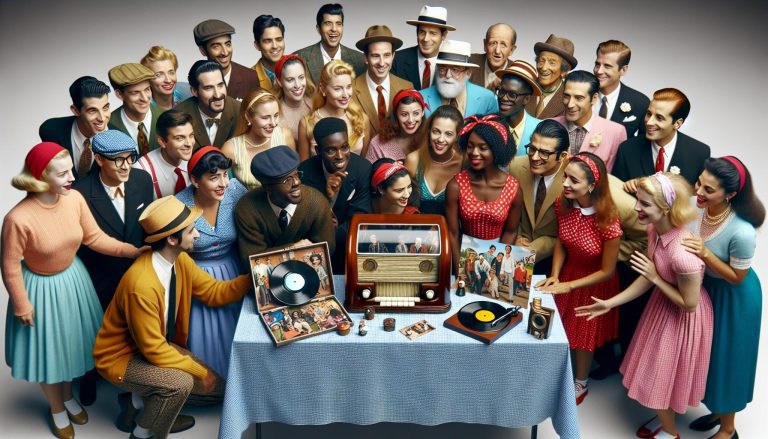Top 1940s Slogans That United a Nation in Wartime
Step back in time to the 1940s, an era where slogans weren’t just catchy phrases but powerful tools that shaped public opinion and rallied the masses. From wartime efforts to post-war rebuilding, these taglines encapsulated the spirit of an entire generation.
You’ve likely heard some of these iconic catchphrases in old movies or history books. They’re more than just words; they’re historical markers that offer a glimpse into the challenges and triumphs of the 40s. Let’s uncover the stories behind the slogans that defined a decade.
“Help win the war”
During the 1940s, slogans weren’t just catchy phrases—they were potent tools for mobilizing the home front and boosting morale. “Help Win the War” became more than just a call to action; it was a personal invocation for every citizen to take part in the war effort.
Imagine every poster, every radio jingle, and every community drive echoing this compelling mantra. You’d see your neighbors conserving food with “Meatless Tuesdays” and “Wheatless Wednesdays.” Films and newsreels amplified this sentiment, urging you to buy war bonds or plant victory gardens.
The impact was profound and widespread:
- Conservation of essential goods became a daily routine.
- The labor force transformed, as women stepped into roles left vacant by men who had gone to fight.
- Recycling took on new meaning with scrap drives to collect rubber, tin, paper, and even cooking fat for military use.
This wasn’t merely a government directive. Businesses adapted their messaging to fit the wartime narrative, understanding that their survival was tied to the nation’s victory. Ads for consumer goods were peppered with patriotic themes, aligning everyday purchases with the campaign to “Help Win the War.”
Celebrities joined in, using their influence to galvanize the public. Icons like Bing Crosby and Bob Hope performed in USO shows, bringing a slice of home to soldiers overseas. They were the influencers of their day, their voices a rallying cry for the war effort.
You couldn’t escape the reach of these messages. They infiltrated every aspect of life during the ’40s, uniting Americans in a common cause and demonstrating the power of words to inspire action and change behaviors.
Every effort, no matter how small, was seen as a contribution to a much larger endeavor—victory in an already tumultuous era. By fulfilling these roles, citizens felt a sense of purpose and belonging, embodying the very essence of the slogan itself. Through collective sacrifice and resolve, they hoped to achieve a future of peace and prosperity—proof enough of the indelible mark these few words left on a nation at war.
“Buy war bonds”

During the 1940s, war bonds became a symbol of patriotic duty. You might be familiar with the iconic posters featuring Uncle Sam or Rosie the Riveter, urging citizens to “Buy War Bonds.” These campaigns were crucial in funding the war effort, serving not only as investment opportunities for Americans but also as a way to support their nation at a time of need.
Purchasing war bonds was pitched as an act of loyalty and service. Here’s how they worked:
- War bonds were government-issued savings bonds, also known as Series E bonds.
- They offered a fixed rate of interest over a maturity period of ten years.
- Citizens were told that buying bonds was a way to “fight without a uniform” as the funds lent to the government financed military operations and helped to curb inflation.
The Public Appeal
The messaging strategy was clear: buying a war bond was your personal contribution to a greater victory. Celebrities of the era, including Hollywood stars and sports icons, led by example. They were often seen and heard promoting war bonds, bringing star power to the campaign. This wasn’t just about encouraging; it was about involving everyone in a common cause.
Here are a few ways the campaign reached you:
- Theatrical newsreels featuring bond drives
- Door-to-door solicitations
- Radio broadcasts and community events
Impact On The Home Front
While contributing to the nation’s success, war bonds also affected the economy at home. Massive amounts were raised—by 1945, over $185 billion, equating to roughly $2 trillion today. The amount of financial support from civilians was staggering; it exemplified the collective effort put forth by Americans from all walks of life. In fact, this widespread movement went beyond monetary contributions; it instilled a sense of unity and shared purpose.
| Year | War Bonds Sales (in billions) | Equivalent Value Today (approx.) |
|---|---|---|
| 1945 | $185 | $2 trillion |
As the war progressed, the attitude towards buying war bonds shifted from a duty to a tangible symbol of hope. They became cherished gifts, signifying sacrifice and the dreams of a post-war future. Many families displayed them proudly, knowing that they had done their part for a conflict that touched every corner of American society.
“Do your part”

During the 1940s, the call to action “Do Your Part” resonated in homes across America. This wasn’t just a tagline; it was a commitment. You could see the impact of those three simple words everywhere, from manufacturing to daily life. They reminded everyone that every action, no matter how small, contributed to the broader war effort.
Factory workers and homemakers alike embraced newfound responsibilities, knowing their individual efforts were critical. There was a sense that no job was too minor, no sacrifice too great when it came to supporting the troops and ensuring victory abroad. You brought the battles home as personal missions through your actions and choices.
- Families planted victory gardens
- Housewives saved cooking fats for munitions
- Children collected scrap metal for recycling
These were just a few ways you were encouraged to participate and make a direct contribution to the war effort. The idea was simple: pitch in and support the cause. The government, through posters and campaigns, made sure everyone knew that the collective small deeds added up to massive support for the frontline.
War production became a personal affair. Rationing forced you to evaluate your daily consumption and find creative ways to do more with less, fostering resourcefulness and resilience. For many Americans, this wasn’t just about rationing; it was about willingly adjusting lifestyles for the greater good, a testament to the impact and significance of the slogan within the fabric of everyday life.
Industries shifted their focus too. Automobile plants were retooled to make planes and tanks. You saw clothing designers trading fashion for functionality, responding to fabric shortages and the needs of a nation at war. It showed in every sector; adaptation wasn’t just encouraged—it was expected.
This rallying cry went beyond mere words, becoming deeply ingrained in the ethos of the decade. “Do Your Part” wasn’t a fleeting catchphrase but rather a continuous call to remain engaged, to uphold the spirit of collective patriotism and to labor together for the shared dream of peace and prosperity. Through these combined efforts, you were not just aiding the war; you were shaping the future.
“Keep ’em flying”

Amidst the era’s most compelling wartime slogans, “Keep ‘Em Flying” stands out for its direct appeal to the aviation sector and its soaring impact on public consciousness. Born from the urgency of maintaining air superiority, the slogan aimed to boost the morale of pilots and ground crews, while simultaneously igniting the spirit of manufacturing workers forging the aircraft needed for victory.
With “Keep ‘Em Flying,” the stakes were clear: every plane was crucial, and keeping them airborne was a matter of national security. It wasn’t just a catchy phrase; it was a nationwide mission. You could see its influence everywhere—from factory floors buzzing with activity to recruitment posters dotting city streets. It echoed in schools where children built model planes and in donations that funded new aircraft; everyone was pulled into the vortex of wartime production.
- Motivate aircraft workers
- Inspire community participation
- Fund new airplanes
This rallying cry also highlighted the crucial role of women in the workforce. As men went off to fight, women stepped into roles previously deemed unsuitable for them. Rosie the Riveter, an icon of this shift, became synonymous with the “We Can Do It!” attitude that empowered so many. For the women taking over the riveting guns and welding stations, “Keep ‘Em Flying” was not just motivational—it was personal. Every plane that rolled off the assembly line was a testament to their skill and determination.
The power of the slogan extended well beyond the walls of the factories. Community drives and school competitions all harnessed the “Keep ‘Em Flying” spirit to gather essential materials. Newspapers ran stories of individual contributions as proof that the home front was just as critical as the front lines.
As the years rolled on, “Keep ‘Em Flying” evolved from a call to action to a symbol of collective endeavor. Similar to “Do Your Part,” it reminded everyone that their contributions, no matter how small, were vital cogs in the machinery of war. It wasn’t just about keeping the planes in the air; it was about keeping hope alive and fueling the belief that together, a victorious end was within reach.
“A chicken in every pot”

Imagine a nation in the midst of economic recovery, with the government promising prosperity and well-being for its citizens. “A Chicken in Every Pot”, while predating the 1940s, found a renewed resonance during this era. Initially part of a Republican campaign that dated back to the 1928 elections, the slogan was a powerful symbol of the American Dream, offering a vision of affordable abundance in the wake of the Great Depression.
You’ve likely heard this catchy phrase, but the reality it painted became especially poignant during the 1940s. It wasn’t just about putting food on the table; it symbolized the nation’s commitment to ensuring that no family was left wanting for the basics. The slogan captured the essence of the period’s aspirations for domestic stability and economic security.
During this time, your grandparents or great-grandparents might have been striving for that very ideal—a stable home with enough to eat. It showcased an attainable lifestyle, with hard work directly linked to the comfort of one’s family. The simplicity and directness of “A Chicken in Every Pot” appealed to the everyday American, offering a glimmer of hope and normalcy in uncertain times.
Industries influenced by the spirit of this slogan expanded rapidly, with the agricultural sector experiencing a significant transformation. Advances in farming techniques and equipment mirrored the nation’s dedication to producing sufficient food for its rapidly growing population. Companies that could align with the values of abundance and health saw growth, as they capitalized on the widespread mentality that prosperity was just around the corner.
As ordinary citizens, the message was clear: the collective efforts of the nation, from policymakers to individual households, worked toward a future where the symbol of the chicken in every pot could be a reality for all. It wasn’t just about a meal—it was an American ideal, a standard of living that was worth striving for, encapsulating a promise of progress and plenty in every home.
Conclusion
You’ve seen how 1940s slogans were more than catchy phrases; they were a rallying cry that united a nation. “Help Win the War,” “Do Your Part,” and “Keep ‘Em Flying” weren’t just words; they were powerful motivators that sparked action across America. From victory gardens to women’s pivotal roles in the workforce, these slogans shaped a collective consciousness of duty and determination. “A Chicken in Every Pot” further promised a future of prosperity, a vision that drove the nation forward. These slogans were the heartbeat of the era, encapsulating the spirit of resilience and unity that defined a generation. Now, as you reflect on their impact, you’re reminded of the enduring power of words to inspire and mobilize a community towards a common goal.







